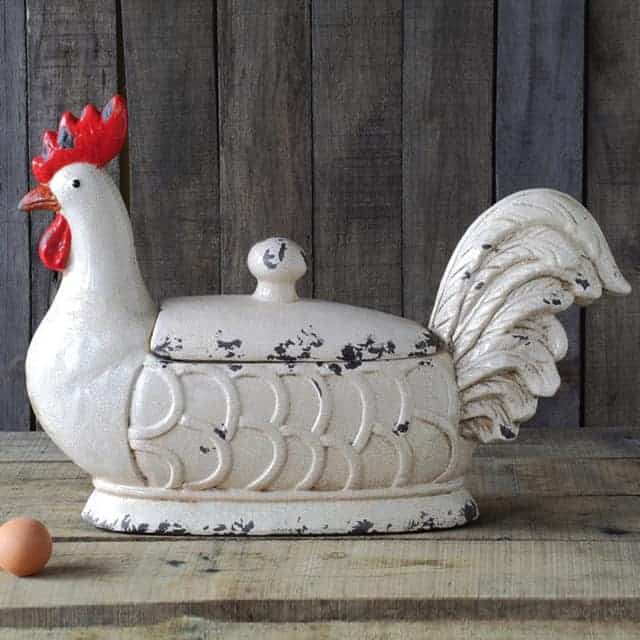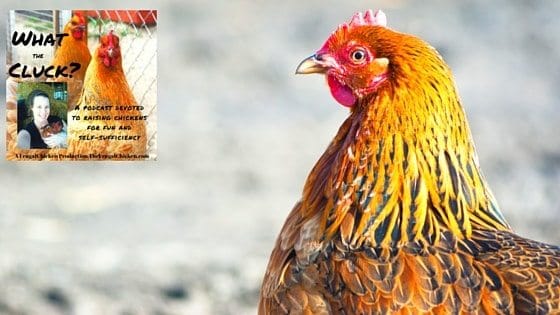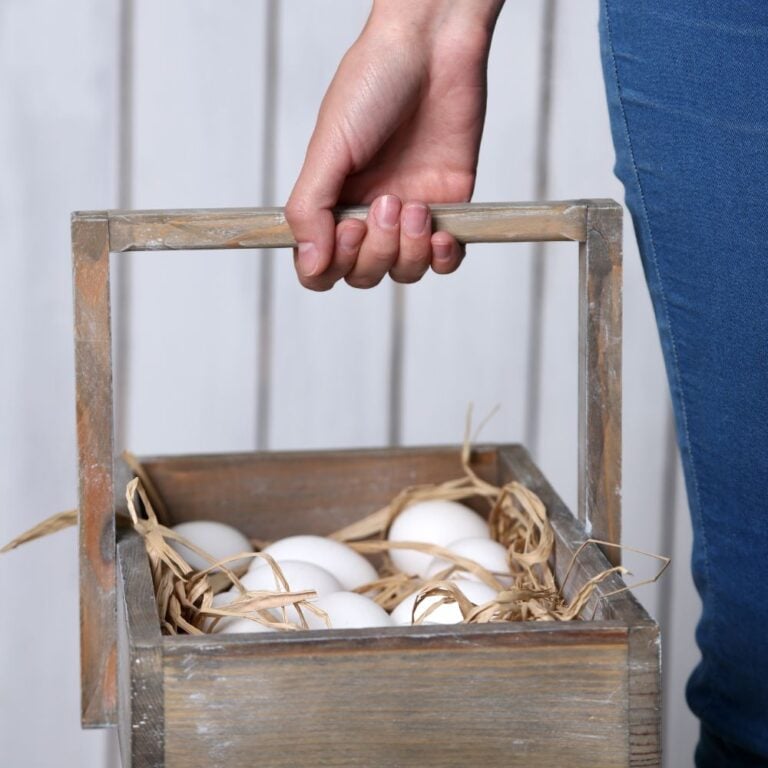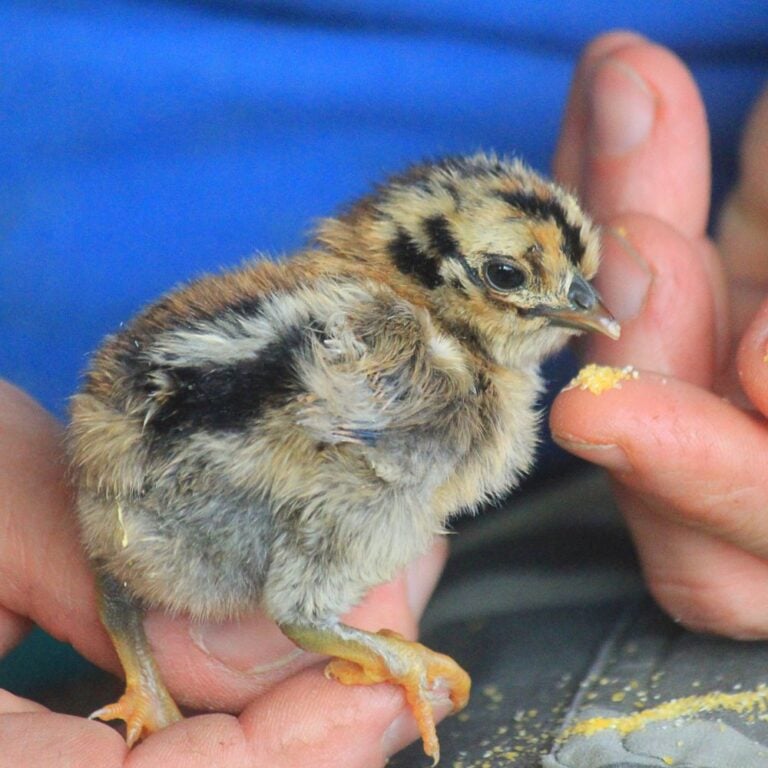Chicken frostbite is something that can happen to the best of them. Of course, we want to avoid it, but it’s not always possible. Learn how to prevent it, and how to care for it.
Yes, chickens can get frostbite, and yes, they can spring back from it. Every year on our farm, we have to tackle frostbite on combs, wattles, and the occasional toe.
You’d think living in the South, we wouldn’t have chickens getting injured from the chilly temperatures. It’s typically in the 30s and 40s here in the winter! It’s not very much fun, but it’s just one of those parts of chicken ownership.
And honestly, we’ve not had any chickens affected long term by it. Most of the chickens just go on about their business.
In my book Chickens: Naturally Raising A Sustainable Flock, I show you how to care for your chickens so they stay healthy, regardless of the season, and there’s detailed information about chickens, frostbite, and the cold. You can buy it on Amazon or directly from me digitally.
If your chickens free range and aren’t kept in a coop during cold temperatures, they’re even more susceptible to frostbite, so it’s important to observe them daily.
In this article, I’m going to show you what frostbite in chickens looks like, when to call the vet, and how to help chickens when they do become victims of frostbite.
The information below is for informational purposes only and isn’t meant to treat, diagnose, or cure. Use your best judgement and always seek a vet’s advice first.
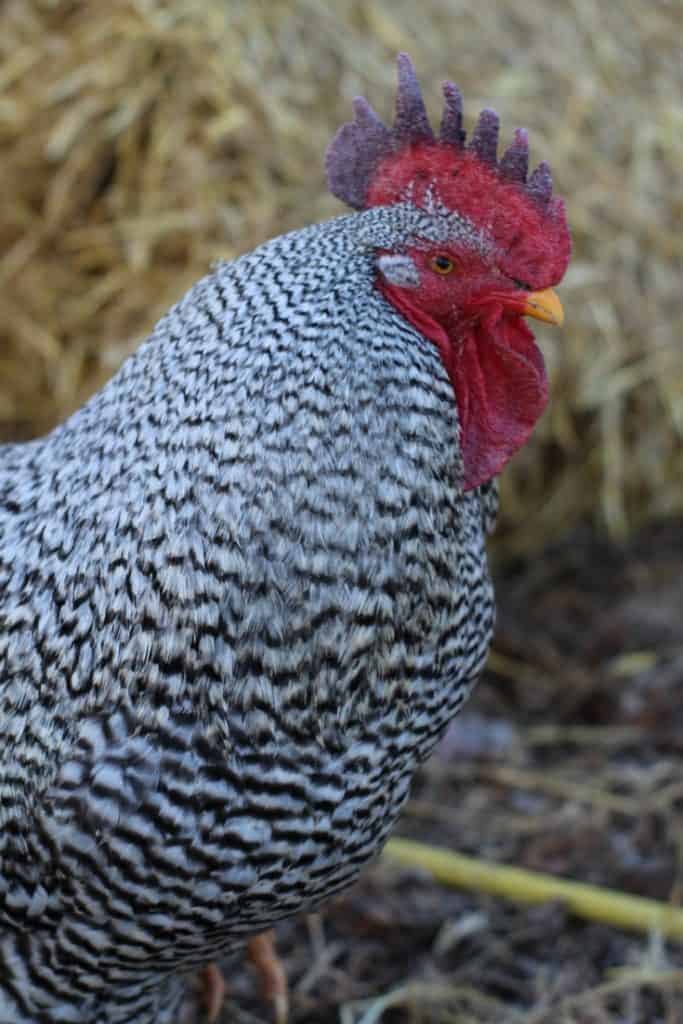
Table of Contents (Quickly Jump To Information)
What Exactly is Frostbite?
In case you’re not 100% sure what it is, here’s a working definition of frostbite (chickens, humans, etc) from Wikipedia:
“Frostbite is when exposure to low temperatures causes freezing of the skin or other tissues. The underlying mechanism involves injury from ice crystals and blood clots in small blood vessels following thawing.”
It’s hard to give an exact temperature when frostbite is an issue for chickens. That is just going to depend. In our area, it’s very cold temperatures of below 20 degrees where we’ve had the most trouble.
Moisture
With chicken frostbite, there’s an extra quirk. It’s not just about cold temperatures.
Unlike conditions like hypothermia, frostbite occurs not just when temperatures are very low, but more often when there are cold temperatures plus moisture.
Yep, good ol’ moisture. Those extra bits of water droplets freeze on the skin, causing more damage than cold temps alone.
Which means that when our chickens drink water (aka dunk their wattles in the water), and can’t get dry (or run away when we try to help them dry), their tiny bodies are more susceptible to frostbite.
Chicken Frostbite Symptoms
The first thing to remember about frostbite and chickens is the condition doesn’t always present in a dramatic way. It might just be a spot here or there on the comb, rather than effecting the entire area.
And it can also be extreme, with blackened areas that have clearly gone necrotic.
Symptoms of chicken frostbite include:
- Dark or blackened areas on the comb, wattles, or feet
- Swelling
- Blisters
- Limping
- Lying down/not wanting to stand
It’s easy to confuse frostbite with fowl pox since they can look similar to blackened areas, but it’s important to also consider the season and other possible causes.
Chickens are unlikely to get frostbite in the summer (obviously). Fowl pox, which also affects the combs and wattles, looks more raised and scabby. You can see photos of fowlpox right here. It’s also possible to confuse frostbite with bumblefoot since both can cause the pads of the feet to swell.
While there are varying degrees of frostbite, what I’ve observed in chickens is that their skin will turn either white or black (depending on severity), and in extreme cases turn black, harden, and start to curl.
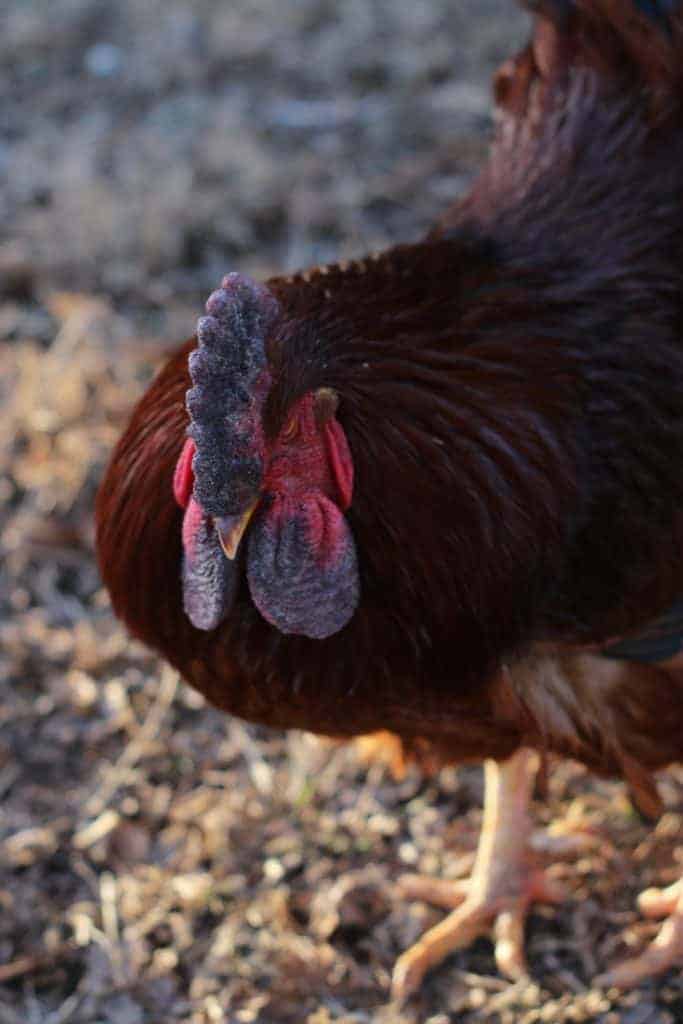
At the point of hardening and curling, it’s likely the skin on your chickens’ combs and/or wattles has died (confirm this with a vet, however).
Toes and feet are relatively rare victims of cold weather here, although, in other areas of the USA, it’s a frequent occurrence. (If toes or feet are involved, you can follow the procedures below.)
Just remember that if this happens to your chickens, it’s not the end of their lives unless it goes untreated.
In nearly all of the cases of frostbite we’ve had on our farm, it’s been mild enough that the skin returns to normal and the chickens are perfectly fine, although it can take a while for the skin to return completely back to normal – it’s been damaged after all!
Preventing Chicken Frostbite
First, let’s talk about chicken frostbite prevention because it’s relatively easy as long as you can catch your chickens. Obviously, there are cold hardy breeds that you have to worry about less. Also, the climate you live in will make or break the risk. Regardless of the various factors, these tips will make your flock more comfortable and less likely to have a problem.
Petroleum Jelly
Petroleum jelly is approved by the Food And Drug Administration as a skin protectant, and that’s because – you guessed it – it protects skin.
Basically, it acts as a barrier between your chickens’ body and the cold and/or wind. If your chickens drink, it will help keep water off their wattles, which also helps prevent frostbite.
We apply it when we get cold snaps, and daily until the temperatures rise.
Shelter
Keeping your chickens inside on particularly cold days or chilly, wet days will reduce the chances your chickens will suffer from frostbite. It’s generally a good idea anyway since freezing rain and wind chill can kill your chickens.
Keeping chickens inside a coop with no drafts can be the difference you need. Do keep in mind that chickens need ventilation, even in freezing cold weather due to ammonia buildup. But you don’t want cold drafts.
Waterer
If your flock keeps getting frostbite because they dunk their wattles in water, then you can change to a different type of waterer, or raise their water dishes off the ground.
A small change as simple as this can make a world of difference.
Insulation
You can put straw on the ground in their coop and run, which is a great insulator. This will not only help keep their feet warmer, it will help the overall warmth of the coop.
Also, if you use the deep-litter method, your coop will naturally be warmer. If you want to learn more about the deep litter method, go here.
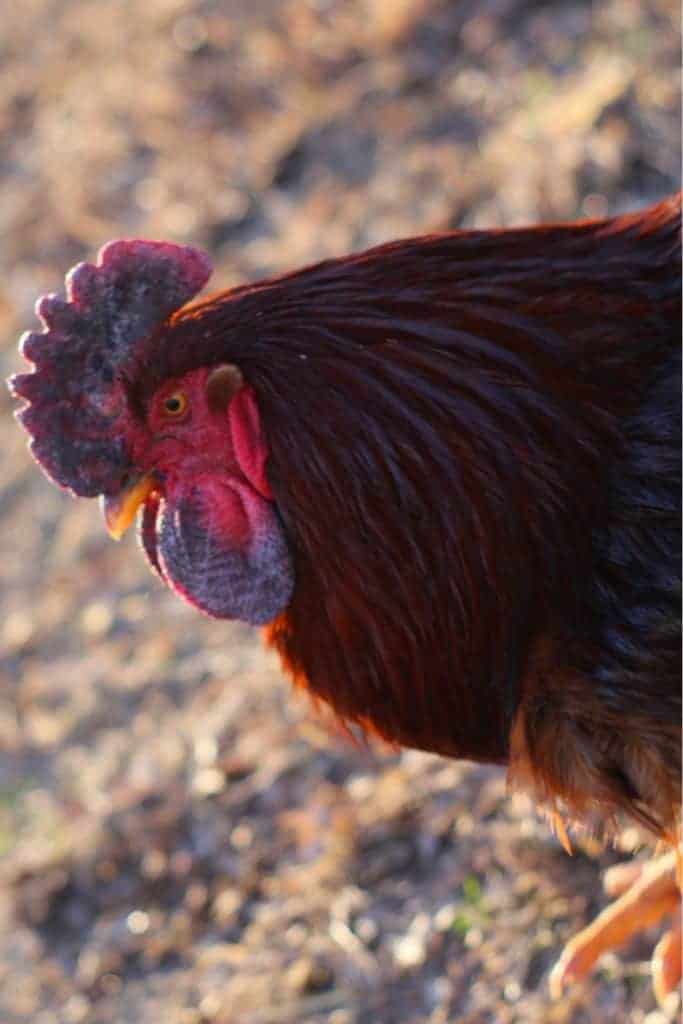
Chicken Frostbite Care
This is what we do on our farm. Use your best judgment to determine what’s best for your flock.
To help chickens affected by frostbite, first identify the area(s) of concern (combs, wattles, limbs, etc).
It’s important not to warm them too quickly (which can cause nerve damage), so bring your chickens inside and allow them to get warm up.
For combs and wattles, you can apply warm water with a cloth until you see circulation return and the area feels warm or “normal.” For feet, you can place them in the lukewarm water until you see circulation return.
Apply an antibacterial ointment (natural or pharmaceutical) to help the skin become healthy and ward off infections.
Place them in a crate in a quiet area with a towel, food, and water, and keep them inside until the very cold has passed or your chickens seem back to normal.
For severe cases (an infection or need to lose a limb from frostbite damage) you should consult with a veterinarian who can advise you. They will likely know whether the affected area should be removed (even a vet inexperienced with chickens can advise you best.) They can also determine if your hen or rooster needs medication, such as antibiotics.
Summary
Frostbite stinks. But, it is something you just might have to deal with. Remember the prevention tips first. After that, you now have some information that can help you care for any flock members that fall prey to frostbite. None of it is complicated, it’s just knowing what to do.
In my book Chickens: Naturally Raising A Sustainable Flock, I show you how to care for your hens so they stay healthy, regardless of the season, and there’s detailed information about chickens, frostbite, and the cold. You can get your copy here.
Addtional Reading
- Heated Chicken Waterers
- Columbian Wyandottes – The Best Unknown Backyard Chicken
- Easter Eggers: Egg Color, Personalities, And More!
- Blue Orpingtons – What You Need To Know
- Light Brahma Chicken – Breed of Splendor
Maat van Uitert is a backyard chicken and sustainable living expert. She is also the author of Chickens: Naturally Raising A Sustainable Flock, which was a best seller in it’s Amazon category. Maat has been featured on NBC, CBS, AOL Finance, Community Chickens, the Huffington Post, Chickens magazine, Backyard Poultry, and Countryside Magazine. She lives on her farm in Southeast Missouri with her husband, two children, and about a million chickens and ducks. You can follow Maat on Facebook here and Instagram here.


